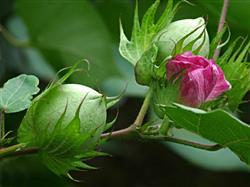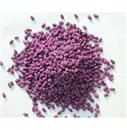Control of bacterial Corner spot in Cotton

First, agricultural measures. 1. Fine soil preparation, application of sufficient fertilizer, irrigation of soil moisture, and selection of disease-resistant varieties. 2. Reasonable crop rotation and deep winter irrigation to promote the decomposition of diseased and disabled bodies. 3. Strengthen mid-tillage at seedling stage, reduce soil moisture, apply less nitrogen fertilizer, increase phosphorus and potassium fertilizer, and cultivate strong seedlings. 4. Strengthen the management of cotton field, drain water in time after rain, remove the remains of diseased plants and take them out of the field and bury or burn them in time, so as to reduce the pathogens in the field. Second, chemical measures. The main results are as follows: 1. Before sowing, the cottonseed is de-tufted with sulfuric acid, which can effectively kill the corner spot pathogen carried on the cottonseed cashmere, as well as other germs transmitted by the seed. 2. After the disease of cotton, 72% agricultural streptomycin can be sprayed evenly with 10 grams of agricultural streptomycin and 30 kilograms of water per mu, or spray 1 Bordeaux liquid with 200 times Bordeaux liquid plus new high-fat membrane.
- Prev

Don't relax in the prevention and control of diseases and insect pests in cotton flower and boll stage.
In recent years, the proportion of transgenic Bt insect-resistant cotton accounts for more than 95% of the total cotton planting area in our province. The popularization of insect-resistant cotton has played a strong role in controlling the occurrence and damage of cotton bollworm in cotton field, but some diseases and pests should be prevented and controlled. from the point of view of this year, cotton boll period is a period of interweaving of many kinds of diseases and pests.
- Next

Measures should be taken to prevent seedling disease from cotton sowing to seedling stage
There are more than ten kinds of cotton seedling diseases, such as blight, anthrax, quenching, root rot and so on, which are collectively called cotton seedling disease. The light ones grow slowly, wilt late, and the heavy ones lack seedlings and break ridges, die in pieces, and do great harm. After the occurrence of cotton seedlings, although a series of disease prevention and treatment measures were taken, such as timely release of plastic film cotton, near the root.
Related
- The first cup of black tea in spring, the flavor and history of tea gardens in Kenya, Africa
- The computer can not only choose potatoes, but also grow tea rice. AI will grow winter oolong tea champion.
- It is not only the inflated tea bitten by insects, but also engraved with the four seasons tea in Beipu.
- The Oriental Beauty Tea Festival in Zhuxian County takes the stage at the weekend to experience the plus-size feast of oil tea.
- & quot; Oriental Beauty Tea & Exploration of Emei in Hsinchu, the hometown of quot;
- The new variety of strawberry "Tainong 1" dessert is the first choice with mellow aroma. Crimson gorgeous
- History of Tea in Taiwan: from Wild Inner Mountain to Export Tea Garden
- Two types of Taiwan Oriental Beauty Black Tea won the British three-Star Award for Childhood Tea Xiang Zhang Jiaqi changed from pilot to champion tea maker.
- Banana species and varieties: the planting history of Taiwan Xianren banana and dwarf banana is long, is banana disease resistant?
- Coffee planting Technology: Qianjie Coffee from Seedling to harvesting

